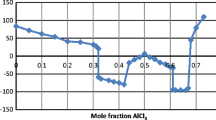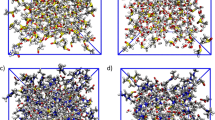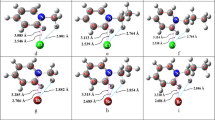Abstract
Density functional calculations have been used to investigate the interactions of 1-(2-hydroxyethyl)-3-methylimidazolium ([C2OHmim]+)-based ionic liquids (hydroxyl ILs) with water (H2O), methanol (CH3OH), and dimethyl sulfoxide (DMSO). It was found that the cosolvent molecules interact with the anion and cation of each ionic liquid through different atoms, i.e., H and O atoms, respectively. The interactions between the cosolvent molecules and 1-ethyl-3-methylimizolium ([C2mim]+)-based ionic liquids (nonhydroxyl ILs) were also studied for comparison. In the cosolvent–[nonhydroxyl ILs] systems, a furcated H-bond was formed between the O atom of the cosolvent molecule and the C2-H and C6-H, while there were always H-bonds involving the OH group of the cation in the cosolvent–[hydroxyl ILs] systems. Introducing an OH group on the ethyl side of the imidazolium ring may change the order of solubility of the molecular liquids.










Similar content being viewed by others
References
Welton T (1999) Room-temperature ionic liquids: solvents for synthesis and catalysis. Chem Rev 99:2071–2083
Dupont J, Souza DRF, Suarez PAZ (2002) Ionic liquid (molten salt) phase organometallic catalysis. Chem Rev 102:3667–3692
Buzzeo MC, Evans RG, Compton RG (2004) Non-haloaluminate room-temperature ionic liquids in electrochemistry—a review. ChemPhysChem 5:1106–1120
Carmichael AJ, Holbrey JD, McCormac PB, Seddon KP (1999) The Heck reaction in ionic liquids: a multiphasic catalyst system. Org Lett 1:997–1000
Sheldon R (2001) Catalytic reactions in ionic liquids. Chem Commun 23:2399–2407
Hallett JP, Welton T (2011) Room-temperature ionic liquids: solvents for synthesis and catalysis 2. Chem Rev 111:3508–3576
Martins MAP, Frizzo CP, Moreira DN, Zanatta N, Bonacorso HG (2008) Ionic liquids in heterocyclic synthesis. Chem Rev 108:2015–2050
Okamura H, Ikeda-Ohno A, Saito T, Aoyagi N, Naganawa H, Hirayama N, Umetani S, Imura H, Shimojo K (2012) Specific cooperative effect of a macrocyclic receptor for metal ion transfer into an ionic liquid. Anal Chem 84:9332–9339
Janssen CHC, Sanchez A, Kobrak MN (2014) Selective extraction of metal ions from aqueous phase to ionic liquids: a novel thermodynamic approach to separations. ChemPhysChem 15:3536–3543
Wang NN, Zhang QG, Wu FG, Li QZ, Yu ZW (2010) Hydrogen bonding interactions between a representative pyridinium-based ionic liquid [BuPy][BF4] and water/dimethyl dulfoxide. J Phys Chem B 114:689–8700
Takamuku T, Hoke H, Idrissi A, Marekha BA, Moreau M, HondaY UT, Shimomura T (2014) Microscopic interactions of the imidazolium-based ionic liquid with molecular liquids depending on their electron-donicity. Phys Chem Chem Phys 16:23627–23638
Zheng YZ, Wang NN, Luo JJ, Zhou Y, Yu ZW (2013) Hydrogen-bonding interactions between [BMIM][BF4] and acetonitrile. Phys Chem Chem Phys 15:18055–18064
Zhu X, Sun H, Zhang D, Liu C (2011) Theoretical study on the interactions between methanol and imidazolium-based ionic liquids. J Mol Model 17:1997–2004
Wang Y, Li H, Han S (2006) Theoretical investigation of the interactions between water molecules and ionic liquids. J Phys Chem B 110:24646–24651
Pomelli CS, Chiappe C (2013) Computational studies on organic reactivity in ionic liquids. Phys Chem Chem Phys 15:412–423
Pomelli CS, Chiappe C, Vidis A, Laurenczy C, Dyson PJ (2007) Influence of the interaction between hydrogen sulfide and ionic liquids on solubility: experimental and theoretical investigation. J Phys Chem B 111:13014–13019
He H, Chen H, Zheng Y, Zhang S, Yu Z (2015) Hydrogen-bonding interactions between a pyridinium-based ionic liquid [C4Py][SCN] and dimethyl sulfoxide. Chem Eng Sci 121:169–179
Roth C, Appelhagen A, Jobst N, Ludwig R (2012) Microheterogeneities in ionic-liquid–methanol solutions studied by FTIR spectroscopy, DFT calculations and molecular dynamics simulations. ChemPhysChem 13:1708–1717
Blanchard LA, Brennecke JF (2001) Recovery of organic products from ionic liquids using supercritical carbon dioxide. Ind Eng Chem Revs 40:287–292
Seddon KR, Stark A, Torres M (2000) Influence of chloride, water, and organic solvents on the physical properties of ionic liquids. Pure Appl Chem 72:2275–2288
Holbrey JD, Reichardt WM, Nieuwenhuyzen M, Sheppard O, Hardacre C, Rogers RD (2003) Liquid clathrate formation in ionic liquid–aromatic mixtures. Chem Commun 20:476–477
Zhang SG, Qi XJ, Ma XY, Liu LJ, Zhang QH, Deng YQ (2012) Investigation of cation–anion interaction in 1-(2-hydroxyethyl)-3-methylimidzaolium-based ion pairs by density functional theory calculations and experiments. J Phys Org Chem 25:248–257
Dzyuba SV, Bartsch RA (2002) Expanding the polarity range of ionic liquids. Tetrahedron Lett 43:4657–4659
Zhang SG, Qi XJ, Ma XY, Lu LJ, Deng YQ (2010) Hydroxyl ionic liquids: the differentiating effect of hydroxyl on polarity due to ionic hydrogen bonds between hydroxyl and anions. J Phys Chem B 114:3912–3920
Sun J, Lu B, Wang X, Li X, Zhao J, Cai Q (2013) A functionalized basic ionic liquid for synthesis of dimethyl carbonate from methanol and CO2. Fuel Process Technol 115:233–237
Yuan X, Yan N, Katsyuba SA, Zvereva EE, Kou Y, Dyson PJ (2012) A remarkable anion effect on palladium nanoparticle formation and stabilization in hydroxyl-functionalized ionic liquids. Phys Chem Chem Phys 14:6026–6033
Werner T, Tenhumberg N, Büttner H (2014) Hydroxyl-functionalized imidazoles: highly active additives for the potassium iodide-catalyzed synthesis of 1,3-dioxolan-2-one derivatives from epoxides and carbon dioxide. ChemCatChem 6:3493–3500
Wang L, Jin X, Li P, Zhang J (2014) Hydroxyl-functionalized ionic liquid promoted CO2 fixation according to electrostatic attraction and hydrogen bonding interaction. Ind Eng Chem Res 53:8426–8435
Wulf A, Fumino K, Ludwig R (2010) Spectroscopic evidence for an enhanced anion–cation interaction from hydrogen bonding in pure imidazolium ionic liquids. Angew Chem Int Ed 49:449–453
Remsing RC, Wildin JL, Rapp AL, Moyna G (2007) Hydrogen bonds in ionic liquids revisited: 35/37Cl NMR studies of deuterium isotope effects in 1-n-butyl-3-methylimidazolium chloride. J Phys Chem B 111:11619–11621
Dong K, Zhang SJ, Wang DX, Yao XQ (2006) Hydrogen bonds in imidazolium ionic liquids. J Phys Chem A 110:9775–9782
Fumino K, Wulf A, Ludwig R (2008) The cation–anion interaction in ionic liquids probed by far-infrared spectroscopy. Angew Chem Int Ed 47:3830–3834
Li XF, Sevilla MD, Sanche L (2003) DFT investigation of dehalogenation of adenine-halouracil base pairs upon low-energy electron attachment. J Am Chem Soc 125:8916–8920
Chen XY, Jing YY, Yang XZ (2016) Unexpected direct hydride transfer mechanism for the hydrogenation of ethyl acetate to ethanol catalyzed by SNS pincer ruthenium complexes. Chem Eur J 52:586–591
Perdew JP, Burke K, Ernzerhof M (1996) Generalized gradient approximation made simple. Phys Rev Lett 77:3865–3868
Li HY, Lu YX, Zhu X, Peng CJ, Hu J, Liu HL, Hu Y (2012) CO2 capture through halogen bonding: a theoretical perspective. Sci China Chem 55:1566–1572
Zhu X, Lu YX, Peng CJ, Hu J, Liu HL, Hu Y (2011) Halogen bonding interactions between brominated ion pairs and CO2 molecules: implications for design of new and efficient ionic liquids for CO2 absorption. J Phys Chem B 115:3949–3958
Frisch MJ, Trucks GW, Schlegel HB et al (2009) Gaussian 09. Gaussian, Inc., Pittsburgh
Boys SF, Bernardi F (1970) The calculation of small molecular interactions by the differences of separate total energies: some procedures with reduced errors. Mol Phys 19:553–566
Rivera-Rubero S, Baldelli S (2004) Influence of water on the surface of hydrophilic and hydrophobic room-temperature ionic liquids. J Am Chem Soc 126:11788–11789
Köddermann T, Wertz C, Heintz A, Ludwig R (2006) The association of water in ionic liquids: a reliable measure of polarity. Angew Chem Int Ed 45:3697–3702
Crosthwaite JM, Muldoon MJ, Aki SNVK, Maginn EJ, Brennecke JF (2006) Liquid phase behavior of ionic liquids with alcohols: experimental studies and modeling. J Phys Chem B 110:9354–9361
Chapeaux A, Simoni LD, Stadtherr MA, Brennecke JF (2007) Liquid phase behavior of ionic liquids with water and 1-octanol and modeling of 1-octanol/water partition coefficients. J Chem Eng Data 52:2462–2467
Lu Y, Li H, Zhu X, Zhu W, Liu H (2011) How does halogen bonding behave in solution? A theoretical study using implicit solvation model. J Phys Chem A 115:4467–4475
Riley KE, Merz JKM (2007) Insights into the strength and origin of halogen bonding: the halobenzene−formaldehyde dimer. J Phys Chem A 111:1688–1694
Acknowledgments
This work was supported by the National Natural Science Foundation of China (grant no. 21133009), the Scientific Research Foundation of Haust (no. 2015QN012) and the Program for Science & Technology Innovation Talents in Universities of Henan Province (grant no.15HASTIT004).
Author information
Authors and Affiliations
Corresponding author
Rights and permissions
About this article
Cite this article
Zhao, S., Tian, X., Ren, Y. et al. A theoretical investigation of the interactions between hydroxyl-functionalized ionic liquid and water/methanol/dimethyl sulfoxide. J Mol Model 22, 195 (2016). https://doi.org/10.1007/s00894-016-3063-4
Received:
Accepted:
Published:
DOI: https://doi.org/10.1007/s00894-016-3063-4




